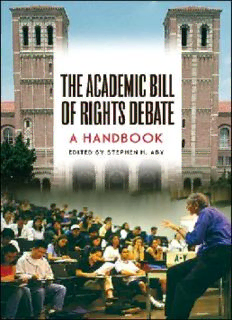
The Academic Bill of Rights Debate: A Handbook PDF
Preview The Academic Bill of Rights Debate: A Handbook
T A B HE CADEMIC ILL OF R D IGHTS EBATE A Handbook Edited by Stephen H. Aby LibraryofCongressCataloging-in-PublicationData Theacademicbillofrightsdebate:ahandbook/editedbyStephen H.Aby. p.cm. Includesbibliographicalreferencesandindex. ISBN978–0–275–99244–6(alk.paper) 1.Academicfreedom—UnitedStates—Handbooks,manuals,etc. 2.Teaching,Freedomof—UnitedStates—Handbooks,manuals,etc. I.Aby,StephenH.,1949– LC72.2.A2862007 378.102130973—dc22 2007022764 BritishLibraryCataloguinginPublicationDataisavailable. Copyright(cid:2)c 2007byStephenH.Aby Allrightsreserved.Noportionofthisbookmaybe reproduced,byanyprocessortechnique,withoutthe expresswrittenconsentofthepublisher. LibraryofCongressCatalogCardNumber:2007022764 ISBN-13:978–0–275–99244–6 Firstpublishedin2007 PraegerPublishers,88PostRoadWest,Westport,CT06881 AnimprintofGreenwoodPublishingGroup,Inc. www.praeger.com PrintedintheUnitedStatesofAmerica Thepaperusedinthisbookcomplieswiththe PermanentPaperStandardissuedbytheNational InformationStandardsOrganization(Z39.48–1984). 10 9 8 7 6 5 4 3 2 1 C ONTENTS Acknowledgments ix 1 ACADEMICFREEDOMINPERILOUSTIMES 1 StephenH.Aby 2 ACADEMICFREEDOMANDTHEACADEMIC BILLOFRIGHTS 17 TheMoreThingsChange?AcademicFreedomThenandNow 17 LawrencePoston What’stoFear:TheAmericanRight,Anti-Intellectualism, andtheABOR 31 KevinMattson AcademicFreedom,FragileasEver 41 MichaelB´erub´e 3 THEAAUP–DAVIDHOROWITZEXCHANGE 53 AcademicBillofRights 53 AmericanAssociationofUniversityProfessors TheProfessors’OrwellianCase 57 DavidHorowitz 4 THEGRAHAMLARKIN–DAVIDHOROWITZDEBATE 67 AnIntroductiontotheDebate 67 MarcusHarvey What’sNottoLikeabouttheAcademicBillofRights 70 GrahamLarkin vi Contents AAUPDishonesty 77 DavidHorowitz LarkinRespondstoHorowitz 79 GrahamLarkin MyReplytoGrahamLarkinandtheAAUP 81 DavidHorowitz Academicvs.HorowitzianTruthStandards 86 GrahamLarkin RelativelyUnbalanced:ReplytoLarkinII 88 DavidHorowitz 5 AREFACULTYTOOLIBERAL?AREUNIVERSITIES TOOCORPORATE? 91 FacultyLiberalismandUniversityCorporatism 91 RudyFenwickandJohnZipp HigherEducationintheTimeoftheCorporateUniversity: RepeatingtheCallforFacultyActivism 108 DavidD.Witt 6 STATELEGISLATIONANDREACTION 121 IsthePopeCatholic?TheStrangeCaseofthe ABORDebateinOhio 121 RodgerGovea InSearchofaProblem:TheStudentAcademicFreedom HearingsinPennsylvania 134 MarkSmith ACaseStudy:TheColoradoExperience 155 DanaR.Waller APPENDICES 175 AcademicBillofRights 175 AAUP1940StatementofPrinciplesonAcademic FreedomandTenure with1970InterpretiveComments 177 WhyanAcademicBillofRightsIsNecessary toEnsureThatStudentsGetaQualityEducation 187 DavidHorowitz Contents vii TestimonybyProfessorJoanWallachScottbeforethe PennsylvaniaGeneralAssembly’sHouseSelectCommittee onStudentAcademicFreedom 192 OhioSenateBill24 199 AmericanCouncilonEducation:StatementonAcademic RightsandResponsibilities 201 AnnotatedSelectedBibliography 203 Index 225 AbouttheEditor,Contributors,andReproducedAuthors 239 A CKNOWLEDGMENTS An edited collection such as this requires the assistance of numerous individ- uals, over and above the contributions of the authors. I extend my thanks to Elizabeth Potenza of Praeger Publishers, Suzanne Bergmiller of Greenwood Publishing Group, and Susan Slesinger of Praeger and Greenwood Publish- ing Group for their prompt and valuable assistance in bringing the project along and preparing it for final production. Greenwood Publishing Group graciously gave permission to reprint selec- tive annotations included in the annotated bibliography from Academic Freedom: A Guide to the Literature (Compiled by Stephen H. Aby and James C. Kuhn IV; Copyright (cid:2)c 2000 Stephen H. Aby and James C. Kuhn IV). Wendi Maloney and Gwendoyn Bradley (AAUP), Sara Dogan (Students for Aca- demic Freedom), Elizabeth Ruiz (Center for the Study of Popular Culture), Heather Hillard (Pennsylvania House of Representatives Archives), and Sara Haywood (American Council on Education) were very helpful in obtaining permissions to reprint various documents. I also thank Graham Larkin and David Horowitz for granting me permission to publish most of their exchange. Although space limitations prevented publishing all of it, the full exchange, with various embedded links to other sources, can be found at the Web site for the California Conference AAUP at http://www.aaup-ca.org. State legislative documents and testimony were reproduced as part of the public domain, although I thank Aleah McDonald of Ohio State Senator Joy Padgett’s office for providing the David Horowitz testimony. Renee Wilson provided invaluable assistance in formatting parts of the manuscript. Finally, I thank Martha McNamara, Jim Kuhn, and Julie Schmid for providing feedback on the introduction, whose remaining defects are my responsibility alone. CHAPTER 1 A F P T CADEMIC REEDOM IN ERILOUS IMES Stephen H. Aby In 2003, David Horowitz, former student leftist and current activist for the conservative right, launched Students for Academic Freedom, an organization devoted to exposing alleged liberal bias in academia and promoting the aca- demic freedom rights of students. Horowitz wrote and distributed an Aca- demic Bill of Rights (ABOR), as well as a Student Bill of Rights, which he hoped would be championed by students, university administrations, and poli- ticians. The stated goals of the movement were to force colleges and univer- sities to provide balance in the viewpoints expressed in classrooms; to diversify the faculty, who Horowitz believed to be predominantly liberal; and to grant conservative-thinking students the academic freedom he said they were being denied. In just three short years, the debate over the ABOR has become one of the most controversial issues in America’s colleges and universities. By November of 2006, it had alreadygenerated 74 articles in major newspapers, at least 143 articles in all newspapers nationwide, 54 television and radio broadcasts, 47 news wire articles, 20 articles in The Chronicle of Higher Education, 73 articles in InsideHigherEd.com, dozens of articles in major magazines, and some 154,000 hits in the obligatory Google search.1 Few academic topics have cre- ated such a furor in so short atime.One would havetogo back to the debates over political correctness on campuses or the publication of The Bell Curve to find a similar flurryofpopular debateover aseeminglyacademic subject. Although the ABOR is a recent and controversial attack on traditional notions of academic freedom rights and protections, it is not new. Indeed, pro- ponents of the traditional values and institutions of academic freedom have seen the ABOR as merely the latest in a long series of threats to the inde- pendence and openness of the academy. At its core, the ABOR rests on a dis- armingly simple contention that conservatives have been arguing for at least the last two decades—that is, higher education has been overtaken by ‘‘tenured radicals’’ who skew the knowledge that is taught in an attempt to indoctrinate students.
Description: